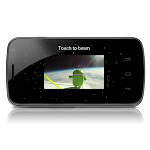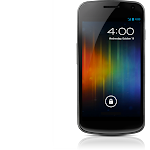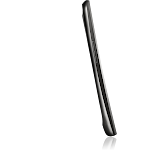There are two things I has immediately notice about Galaxy Nexus. The first is the large screen with high resolution. The second is that the phone no protruding buttons are on the front. Instead of the usual Android buttons, Samsung and Google have chosen to show three buttons that are most often visible in the bottom of the screen.
The buttons disappear when you run certain functions and programs. Sometimes they disappear completely, and then you have to first touch a different part of the screen to get them to reappear. Sometimes they change instead of three small dots on the edge of the screen.
Leverages the screen well
The idea of exploiting the phone's surface by allowing the buttons to be part of the screen is basically good. For example, when watching movies, have even a tenth of an inch of screen space impact.
The buttons, however, could just as well be at a predictable place and then disappear at selected times, instead of, for example when watching movies.
Partly it's definitely a habit, but after a period of use of the Galaxy Nexus, I still constantly think about me, especially when I can not find the rewind button, where I expect it to be.
If you are accustomed to Android, also notes that in addition to the back button are a home button and a new button that displays a list of thumbnails of the apps that you last used.
Menu button missing and the menus reached now through a symbol which also appears in the form of three dots. Sometimes, this symbol in the upper part and sometimes in the lower part of the screen when you are in an app.
Appearance and design
In addition, you can feel the changes in Android 4.0 greatly concerned with appearance and design of various functions.
"Contacts" has been renamed the "People" and has a new look. If you have grouped your contacts, it is simpler to show the members of a group. But there is no double view, which was available in Android 3.0-version, where you can get a list of contacts on one side of the screen while watching a single contact's information on the other part.
Even in the Gmail application, I had a vain hope for a similar solution with two separate views as in 3.0. But it's probably one of those differences, which Google thinks there should be between tablets and phones, though they said that 4.0 would be a common system.
The usual e-mail app is in fact not really seemed to be adapted for the screen resolution.
The browser also has a new design. Pressing the tab icon you get an overview of all open web pages in a reduced form, much clearer and nicer than in the Text menu, you had to do with the previous version.
The part of the system, where previously only installed apps, is now divided into two tabs which apps are on one tab and widgets on another. It gives a better overview of what widgets are and especially how they look.
It has also improved the setup menu that can be reached via notifications list that have been quick buttons for Bluetooth and WLAN at the top. It also has a clear measure of data traffic.
Notifications list has also changed. When you pull down the list and have several notifications, you do not choose that everyone must be cleared. Pushing sideways, you can choose one at a time.
But depending on what action other manufacturers choose to do, get a larger or smaller part of these changes also to the other Android models. So how is the phone itself?
Big screen
As long as no producer has launched a flexible screen that can be folded or rolled, there will be a link between the screen and the phone's size. I must admit that my personal view of what is the optimum size for a mobile screen has been amended several times in recent years.
At the risk of regret it later, I think that the 4.65-inch screen, which Galaxy Nexus has, is very close to the limit where the size becomes too much - at least for me. With some hesitation I approve phone format, while I am aware that many see the screen size alone as a plus.
Sensible camera
It is without doubt the screen, there is this phone's strongest card when it comes to multimedia.
The camera is fast stills, it does video capture at 1080p, and you can definitely have fun with making video recordings with Galaxy Nexus. Especially people who like to film and distort their facial extractions with various live-effects.
The resolution of images is only based on 5 megapixels, which may irritate some, and functions that add artificial backgrounds, requires a smooth solid colors to really work.
Lock up your face
Something that contrast works surprisingly well is the ability to unlock the phone with the user's face.
The reading is quick and the function does not require the same facial expression, good lighting conditions, or that you look straight into the camera on the front. An absolute certainty will not, but I think it is a good compromise, considering how fast it locks up.
If you like big screens and want to be first with Android 4.0 and future versions, the Galaxy Nexus definitely the right choice, otherwise it has some weaknesses that you should consider.
Samsung Galaxy Nexus facts, price, rating
- Type: Smartphone with Android
- Weight: 135 grams
- Dimensions: 135.5 x 67.94 x 9.47 mm
- OS: Android 4.0
- Memory: 16/32 GB internal, no room for memory cards
- Maximum data rate: 21 Mbit / s turbo-3G, WLAN 802.11 b / g / n
- Connection to PC / Mac: Via USB or Bluetooth
- Bluetooth: Yes
- Voice Guidance: English only
- Ringtones: Music Files
- Display: 4.65 inch, 1280 x 7200 pixels, 16 million colors
- Game: Can be downloaded from Android Market
- Camera: 5 megapixel with autofocus and photo light, video recording at 1080p, panoramas
- GPS: Yes
- Email: POP / IMAP, Gmail, Exchange
- Other Features: Browser, calendar, calculator, music player and more
- Accessories: Stereo Headset, USB cable and charger included
- Price: 23,250/- INR
- Manufacturer's website: www.samsung.com
12 Fast Features
- Camera
- GPS
- FM radio
- NFC
- Memory card slot
- Dual Core processor
- Turbo-3G
- Wi-Fi
- Wi-Fi hotspot
- DLNA
- Bluetooth
The first thing I respond to is how fast the phone is. Yes, there sits a 1.2-GHz dual-core processor, but the screen resolution is 1280 x 720, about the same as tablets with dual core processors, struggling to get Android 3.1 to look good in. Otherwise perceived differences most as cosmetic, although I like the improved browser. Like Henry, I have a hard time that you have removed the menu button, and I think that the phone's screen is just big enough, especially when you consider that Android has a tendency to throw out features in the screen corners.
Plus
The screen
Browser
Minus
You really miss buttons below the screen
Questions and Answers
Does it have HDMI output?
Galaxy Nexus only has a USB connector, as with an HDMI adapter can be used to display images and movies on larger screens.
How does Android Beam function?
By placing the two phones against each other, you can transfer programs, files, contacts and links via NFC.
What does the hidden LED, located below the screen?
It becomes visible and flashes when you have messages or missed calls.
Alternative:
A much cheaper option is the predecessor Nexus S. If you like big screens, the HTC XL a similar Android.
Character
Telephony and data 9/10
Multimedia 8/10
System and program 9/10
User Experience 8/10
Material and quality of 8/10
Total: 84%
Samsung Galaxy Nexus Images/Pics/Photos & Gallery
 |  | 
|
 |  | 
|
 |  | 
|

0 comments:
Post a Comment